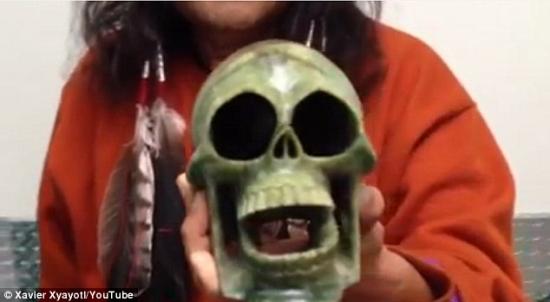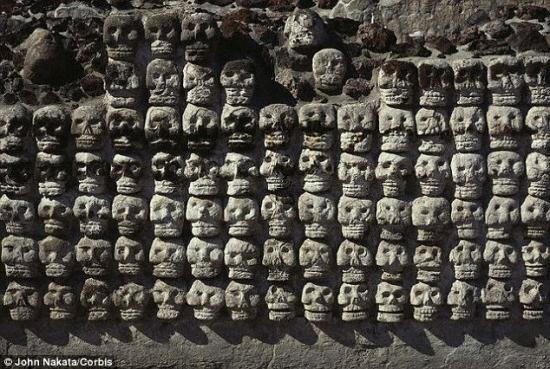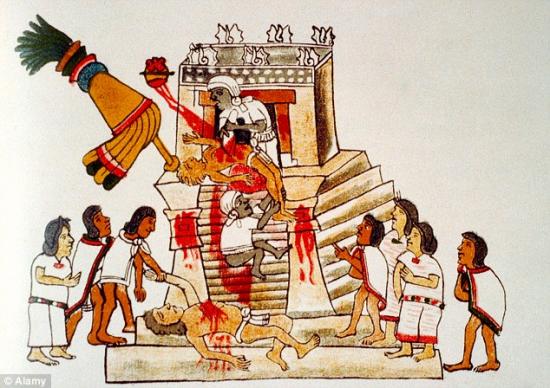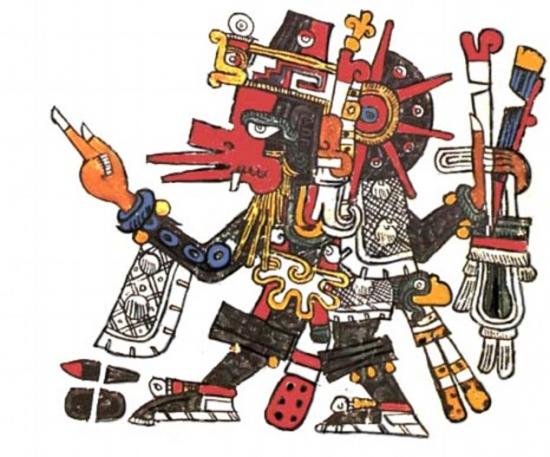'Screaming' from carved skull may have accompanied human sacrifices
Sarah Griffiths
Source - http://www.dailymail.co.uk/sciencetech/article-2857363/Listen-terrifying-sound-Aztec-DEATH-WHISTLE-Screaming-carved-skull-accompanied-human-sacrifices.html?ITO=1490&ns_mchannel=rss&ns_campaign=1490
Skull-shaped whistles may have been used by Aztecs before they were killed in ceremonies to honour the god of wind, Ehecatl
-
Two whistles were found in the hands of a skeleton in front of the temple
-
Sound produce has been linked to screaming corpses and howling wind
-
Instruments may also have been used in battle, to intimidate rival tribes
It’s almost impossible to imagine the terror that ancient men must have felt as they waited to be sacrificed by decorated Aztec priests.
But experts have revealed that a terrifying noise would have accompanied the grisly ritual and it was emitted by skull-shaped whistles.
The sound the horrifying death whistles make has been captured on film and they sound like humans howling in pain, spooky gusts of whistling wind or the ‘scream of a thousand corpses’.

An engineer has been studying a terrifying noise that would have accompanied the Aztec's grisly ritual of human sacrifice. Death whistles (one is pictured made from jade) are thought to have been blown by people who were about to be slain and sound like humans screaming in pain or whistling wind
Discovered decades ago, the whistles attracted the attention of archaeologists because of their skull shape, but it is only recently that their fearsome noise has been investigated.
Some experts have said that the Aztecs likely used the noise to help people’s souls travel to the afterlife when they were sacrified in front of square temples, but the whistles may also have been used by warriors to intimidate enemies at the beginning of battle.

The skull is a common motif in Aztec art (a temple wall is pictured) associated with death and sacrifice, and many death whistles bear its shape. The whistles are also associated with death rituals because two examples were found in the hands of a sacrificed male skeleton in front of the temple of wind god Ehecatl
Roberto Velázquez Cabrera, 66, an engineer who lives in Mexico, has spent years trying to reconstruct the instruments of the ancient Aztecs to examine the sound they make and experts think the noise of the death whistle also relates to the wind.
The whistles are associated with death rituals not only because of the skull decoration, but because two examples were found in the hands of a sacrificed male skeleton in front of the temple of wind god Ehecatl at Tlatelolco, he wrote in an article for Mexicolore.
The finding suggests that the whistles were linked with Ehecatl and the 'Wind of Mictlantecutli' (death).
When the sound of a death whistle dating from between 1250 and 1380 was analysed, the noise it generated was likened to the howling wind and the strongest frequencies fell within the range of human hearing, which is 1kHz to 6kHz, adding weight to theories that they were designed to be used in ceremonies and to intimate tribes.
The first drawings of the whistles were only published in 1971 - one of a skull and another of an owl, - which in Mexican culture is associated with the coming of death.
Archaeologists have also found other types of whistles serving specific purposes that were used by the Aztecs which were constructed from different materials, such as clay, feathers, sugar cane and even frog skins, Oddity Central reported.
For example, conch shells were used to start ceremonies, while hunters used animal-shaped instruments to make noises to attract deer.
It is thought that ancient doctors tried to use sounds to cure illnesses too.

Some experts have said that the Aztecs likely used the noise to help people’s souls travel to the afterlife when they were sacrified in front of square temples (illustrated), but the whistles may also have been used by warriors to intimidate enemies at the beginning of battle
A death whistle made from Jade creates a different, but equally terrifying noise

The finding suggests that the whistles were linked with the wind god Ehecatl (illustrated) and the wind and Mictlantecutli (death). His temple was built as a cylinder in order to reduce the air resistance and was sometimes portrayed with two protruding masks through which the wind blew
WHO WAS EHECATL?
It is thought the death whistles were linked to Ehecatl - the god of wind.
He is usually shown with two masks through which the wind blew and his temple was cylindrical because wind blows in all directions.
In the Aztec creation myth, three gods gathered in a sacrificial fire and became the sun and moon. They were immobile until Ehecatl blew on them. In a later legend, he helped sacrifice all the gods apart from one, who escaped to light up the world.
It is thought the ancient culture sacrificed humans to pacify Ethecatl.
Death whistles were found in the hands of a sacrificed male skeleton in front of the temple of Ehecatl.
Listen to the Disturbing Sound of the Aztec 'Death Whistle'
https://www.youtube.com/watch?v=KWyP17m46A0
https://www.youtube.com/watch?v=n1XkP-xRj7E